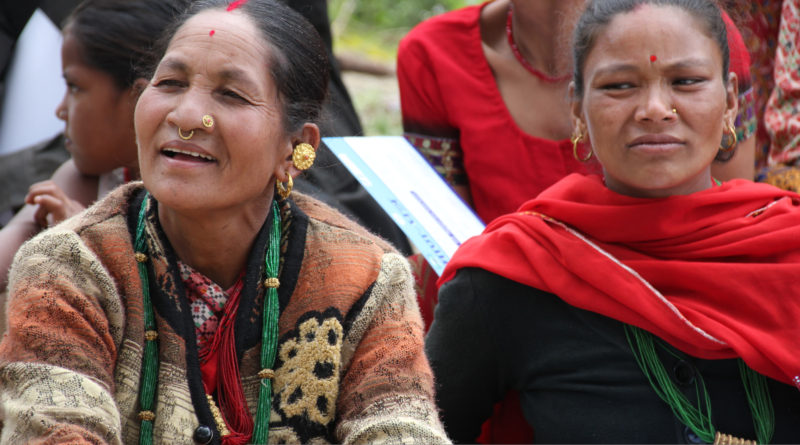Overcoming Patriarchy in the Church in Asia: The Role of Men by Y. Franklin Ishida
Photo caption above: Two Dalit women from the village of Suri celebrate their graduation from the community and human development training they received as part of the post-disaster programs offered through Lutheran Disaster Response.
When I think of overcoming patriarchy, my mind goes no further than my friend and colleague Chandran Paul Martin and the work we do together. Within this, Chandran has taught and mentored me in more ways that he may imagine. One of those big lessons is about his own background: that of a Dalit, the so-called outcastes within Hindu contexts.
Dalits have been rendered “human-less” by a religious-social-political-economic context that ingrains caste into the very psyche of every human being within culturally Hindu contexts. The good news is that technically, once baptized, one no longer lives with caste. However, even as equal baptized children of God, Dalits still live their being as Dalits, within the church and outside, just because this psyche lives on. Because of this, Christian Dalits find themselves “twice-alienated” in a context that already places their Christian faith into a discriminated plane.
To counter this, the Dalit community, being rendered human-less, are led to a common, or communal, aspiration for identity; a return to being in the image of God. “The Dalit situation would emphasize the essential community nature of the Church, the Koinonia, a ‘community of the faithful and a community of love’ wherein each member and all members together, priests and people alike live the Gospel and fulfill in word and deed the mission of the Church, which is to witness to the love and liberating power of God in Jesus Christ in the contemporary society – to respond to the cry of the poor and the oppressed.”[1]
Easier said than done. For Dalit women, they are in a further bind. Even as they live as Dalits, as women in a patriarchal society such as India they are the “thrice-alienated.” Aruna Gnanadason puts it this way: “Dalit women suffer further, being kept powerless, their voices silenced, their dignity and personhood trampled on.”[2]
This is not within the church context, but one way Dalit women are lifted up is in Nepal’s post-2015 earthquake relief programs. Dalit women, in their twice- or thrice-alienated status, don’t have any opportunities whatsoever in a disaster situation. So, with Chandran’s encouragement and in coordination with the Lutheran World Federation Nepal program, ELCA Disaster Response helps fund programs that take Dalit women in far flung remote areas and teaches them literacy, self-confidence, governance, and human rights.
When national elections took place in Nepal in 2018, many of these women were elected to local and regional offices. It’s true certain spots were already reserved for Dalit and for women. But these Dalit women were elected on their own merit within their communities because they could speak out and lead with confidence. Some men did complain about not having a place. But they were quickly (but gently) reminded by these elected women that the men would always have their place: this time it was for women to represent their communities.
What is exciting here is that a whole cadre of women, who otherwise would have not just been invisible because they were Dalit, but also ignored because of their gender, are becoming a part of the governing fabric of today’s Nepal.
In India, many Lutheran churches are made up of Dalits. However, if being in the image of God should uplift even women within the church, that does not happen readily. Once again, Dalit women are twice and thrice alienated despite the churches’ commitment to uplift women.
I have found it frustrating when [male] church leaders state they have no problem with gender justice because women are ordained. But even a pastor status does not shield women from being kept powerless and their voices silenced. Few are offered their own parishes to serve. You don’t see many women, aside from perhaps the solitary women’s wing representative, on church executive councils. And if women raise their voices too much, they are kept from further work that links them to the outside.
Chandran is one who will confront church leaders openly about all this. He gets away with it in ways I cannot as he is from India, lives there, and works within that context, which is his own church(es). As for me, I tread carefully, trying not to offend those very church leaders with whom I have to maintain a relationship as a church-to-church matter.
But Chandran and I do conspire, so to say. We always have questions about assuring the presence and participation of women (and not just the wife of a bishop.) This extends also to young women, who may have their age running against them as well. We push for women to receive higher academic degrees.
It’s difficult not to make this into a quota system or simply a matter of representation. Can women speak for themselves? Can men recognize that this is their issue as well? Can there be a true dialogue about gender: roles, responsibilities, accountabilities, leadership?
Later this year, the ELCA is sponsoring a consultation on gender in India. This is not just a church concern, but will also include voices from other faith communities, such as Islam and Hinduism. And mostly, this will be about women raising their voices of faith and practice, and for men to hear their own voices (of where they are not yet.)
The challenges may be many, but we truly must begin with these very women, whether they be Dalit or otherwise, as they are given their own voice. The experience with Dalit women in Nepal may be a first step of such a process. But we know that men still control so much in society and institutions. Something like the upcoming consultation on gender may be way to hold men and women mutually accountable for who we are as children of God. Only when we can hear these voices, whether it be for the first time or for the tenth time, can we start to see something different about who and what we are as God’s children.
 Franklin Ishida is an ordained pastor in the Evangelical Lutheran Church in America. He serves as the ELCA’s Area Director for Asia and the Pacific, based in Chicago. His background includes a bachelor’s degree in human rights and a master’s in international relations.
Franklin Ishida is an ordained pastor in the Evangelical Lutheran Church in America. He serves as the ELCA’s Area Director for Asia and the Pacific, based in Chicago. His background includes a bachelor’s degree in human rights and a master’s in international relations.
[1] Saral K. Chatterji, “Why Dalit Theology?” contained within A Reader in Dalit Theology, edited by Arvind F. Nirmal (Chennai, India: Gurukul Lutheran Theological College and Research Institute, 2007), p. 48.
[2] Aruna Gnanadason, “Dalit Women, the Dalit of the Dalit” contained within A Reader in Dalit Theology, edited by Arvind F. Nirmal (Chennai, India: Gurukul Lutheran Theological College and Research Institute, 2007), p. 130.

